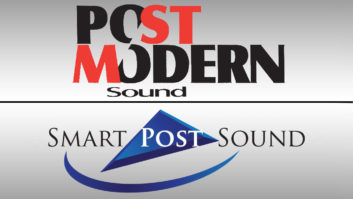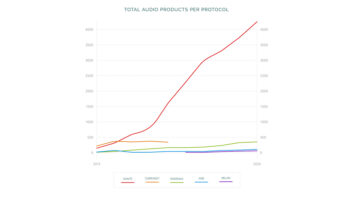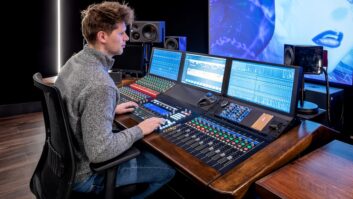One paradox of technological progress is that advances in functionality are soon outstripped by users’ expectations and demands. For example, though the ability to recall session data instantly on a digital workstation enables post-production mixers to recall and remix projects in less time than it takes to rewind and edit a tape, the practical reality is that if a client returns to a multiroom post facility for mix revisions, the workstation on which the session was first posted may well be occupied. In such a situation, the client may have to wait for several minutes while the original session data is recovered and remounted on another workstation. Whether the data is digitally copied over an in-house network, or has been stored on an MO disk or Exabyte tape that must be retrieved via “sneakernet,” the client will have to wait.
A business reality of post-production audio is that clients are notoriously impatient. Any post house that can speed the recovery and reconstitution of old session data for revision and remixing has a competitive advantage.
This is the opportunity that Fairlight’s MediaLink is designed to address. MediaLink is a network solution that allows multiple Fairlight MFX3[superscript]plus and FAME workstations to share audio files with each other and with a central server. According to Andrew Brent, Fairlight’s International Technical Director, MediaLink allows a Fairlight operator to audition selected files that are actually located elsewhere on the network. Instead of copying files across the network to a local hard drive and then playing them back, the operator can listen to sound files across the network-in real time.
This is an important and useful function. As Brent points out, “if you could discipline the operators to arrange their sessions in advance and copy needed sound files ahead of time, then a simple ‘store and forward’ network would suffice. But clients demand that things happen immediately. They need to audition sounds right now.” However, for real-time auditioning of sound files, the network must be capable of sustained and repeatable high-volume data transfer, uninterrupted by other network functions.
The requirement, then, is for a network sol-ution that supports store and forward and real-time operations simultaneously. MediaLink meets this requirement with an innovative and unique complement of advanced technologies.
SECURE DATA STORAGEAt the core of a MediaLink system is a Windows NT-based server, a dual-P2 450MHz machine with 256 MB of memory. The proven 100BaseT network uses TCP/IP protocol, and the system wiring is standard Fast Ethernet Category 5 UTP twisted-pair copper cable. Attached to the server via ultrawide SCSI is a custom high-speed RAID (Redundant Array of Inexpensive Drives) that provides the bandwidth necessary to recover and play up to 80 channels of simultaneous audio.
RAID arrays were originally developed for speedy and secure data storage and delivery. Though RAID is a mature and well-established computer technology, it is not readily applicable to the needs of audio, since most manufacturers optimize their systems for more traditional data manipulation tasks. Playback of multichannel audio is a very specific application, with lots of seeks and relatively small blocks of data being read. “There’s no such thing as real ‘straight-from-the-hard-disk’ streaming audio, except for simple stereo playback,” explains Brent. “For multitrack systems buffering is inevitable, and that requires a system capable of frequent seek and read operations to keep the buffers topped off.”
In fact, RAID comes in several flavors, some more appropriate for streaming audio than others. “RAID 0” offers no data redundancy but spreads the data across multiple drives, speeding read/write times. RAID 1, often called “mirroring,” writes data to two drives simultaneously and offers complete redundancy, though speed is cut in half, since the system is reading/writing to two drives. RAID 3 offers redundancy by spreading data and recovery information across multiple drives and still offers good read/write performance.
MediaLink takes advantage of the merits of multiple RAID formats. “We found that in some instances RAID 4 is good at solving the problem of high bandwidth and a high number of channels recording to the server,” explains Brent. “RAID 5 is more appropriate if you have a small number of tracks recording to the server but a big playback bandwidth requirement in the facility.”
STANDARD COMPONENTSAs Brent points out, the MediaLink system is based on standard components, and the RAID system is one that has been optimized for audio by Silicon Gear, whose R&D team for the RAID controller is in Australia, within shouting distance of Fairlight; manufacturing is in Silicon Valley, Calif. The disk drives are LVD (Low Voltage Differential) drives from Seagate, and the whole system is designed for ease of maintenance-many components are mounted on slide rails and feature PC-style connectors. “RAID defines reliability, but when you really evaluate these systems for real-world applications, they can present problems for the nontechnical owner,” says Brent. “MIS operations typically have a technical staff on hand, whereas in an audio or video facility you have to take into account the level of technical expertise available. For that reason, MediaLink is built on established, robust and tested technologies that are widely available and easy to maintain.”
Though Fairlight application software is proprietary, the network software is based on Microware’s OS9 operating system, and in recent years the company has added standard PCI hardware to the MFX rack and has written code to allow support for other platforms. The universality of TCP/IP allows a Macintosh or a PC to connect to the Media-Link network and move files to and from a Fairlight workstation’s hard drive.
For example, an AVID Media Composer can be added as a node on a MediaLink network. OMF files may be transferred over the network to the server, or MFX workstation, and transfers to and from a PC are also possible using industry standard .WAV files. This interconnectivity allows a Fairlight operator to process sounds with plug-ins from a variety of other manufacturers. The MFX can also function as a Web page server, which allows a client to download needed files over the Internet.
Though MediaLink can be configured with as many as 80 data channels, in the simplest MediaLink implementation, two or more Fairlights operate in a “peer-to-peer” network; there is no independent server, and the two systems may exchange sound files transparently in real time. Typically, the mini-network’s bandwidth is around 40 channels, meaning that 32 channels are available for real-time audio playback, with eight channels reserved for store and forward operations.
Even at its most basic level, a Media-Link server can have up to 15 so-called “JBOD” drives (Just a Bunch Of Disks) connected to simulate something like an SSL SoundNet, but without the need for SCSI switching. At the highest level, a MediaLink server controls a RAID array to provide high-bandwidth playback of up to 80 channels. The network architecture is common to all scenarios.
As Brent notes, in a typical Media-Link-equipped facility Fairlight operators can be using audio clips from both their local drives and the central library on the same project. “It’s like working on your local drive,” says Brent. “You can work like that all day. And if you need to know which sounds are coming off the local drive and which are off the server, the GoTo clipname list will tell you.”
Fairlight, 3855 Hughes Ave., 2nd Floor, Culver City, CA 90232; 310/287-1400. Web site: ww.fairlightesp.com.au







